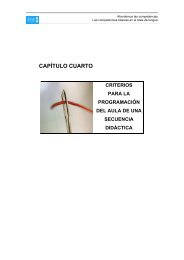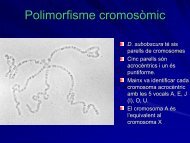Geological and environmental implications of the evaporite karst in Spain
Geological and environmental implications of the evaporite karst in Spain
Geological and environmental implications of the evaporite karst in Spain
You also want an ePaper? Increase the reach of your titles
YUMPU automatically turns print PDFs into web optimized ePapers that Google loves.
Environ Geol (2008) 53:951–965 957<br />
bedrock collapse s<strong>in</strong>khole 15 m deep <strong>and</strong> 75 m <strong>in</strong> diameter.<br />
Clear evidence <strong>of</strong> <strong>the</strong> active dissolution processes that<br />
affect Triassic <strong>evaporite</strong>s is <strong>the</strong> presence <strong>of</strong> sal<strong>in</strong>e lakes <strong>and</strong><br />
spr<strong>in</strong>gs associated with <strong>the</strong>se formations. The Gallocanta<br />
Lake, 13 km 2 <strong>in</strong> area, is located at <strong>the</strong> bottom <strong>of</strong> a limestone<br />
<strong>karst</strong> polje whose deepen<strong>in</strong>g by corrosion processes<br />
ceased when <strong>the</strong> underly<strong>in</strong>g shales <strong>and</strong> <strong>evaporite</strong>s were<br />
reached, propitiat<strong>in</strong>g <strong>the</strong> development <strong>of</strong> this sal<strong>in</strong>e lacustr<strong>in</strong>e<br />
system <strong>of</strong> paramount <strong>environmental</strong> <strong>in</strong>terest (Gracia<br />
et al. 2001) (Fig. 2d). The waters <strong>of</strong> La Sima spr<strong>in</strong>g <strong>in</strong><br />
Santa Cruz de Moya rise through a <strong>karst</strong>ic conduit developed<br />
at <strong>the</strong> foot <strong>of</strong> a slope flow<strong>in</strong>g <strong>in</strong>to <strong>the</strong> Turia River. In<br />
1984, <strong>the</strong> development <strong>of</strong> several s<strong>in</strong>kholes around <strong>the</strong><br />
spr<strong>in</strong>g triggered a l<strong>and</strong>slide <strong>of</strong> 100,000 tons (Durán <strong>and</strong><br />
Del Val 1984). Subsequent to this event, water <strong>of</strong> <strong>the</strong> Turia<br />
River, which supplies Valencia City, was not dr<strong>in</strong>kable for<br />
a few months, due to <strong>in</strong>creased sal<strong>in</strong>ity.<br />
Karstification <strong>of</strong> Tertiary evaporitic rocks<br />
General geological <strong>and</strong> <strong>environmental</strong> <strong>implications</strong><br />
The subsidence phenomena caused by <strong>karst</strong>ification <strong>of</strong><br />
<strong>evaporite</strong>s is <strong>the</strong> topic that has received a wider attention <strong>in</strong><br />
<strong>the</strong> Tertiary bas<strong>in</strong>s. These are particularly frequent <strong>in</strong> <strong>the</strong><br />
sectors where <strong>the</strong> evaporitic bedrock is overla<strong>in</strong> by<br />
Quaternary alluvial deposits which may behave as perched<br />
aquifers (terraces <strong>and</strong> mantled pediments) or as discharge<br />
areas fed by upward groundwater flows (floodpla<strong>in</strong>s). This<br />
alluvial <strong>karst</strong> occurs <strong>in</strong> reaches <strong>of</strong> <strong>the</strong> ma<strong>in</strong> Spanish<br />
fluvial systems where <strong>the</strong>y traverse evaporitic outcrops<br />
(Gutiérrez <strong>and</strong> Gutiérrez 1998; Benito et al. 2000; Gutiérrez<br />
et al. 2001; Guerrero et al. 2007) (Fig. 1). Commonly,<br />
<strong>in</strong> <strong>the</strong>se areas <strong>the</strong> alluvial deposits show sharp<br />
thicken<strong>in</strong>gs, locally reach<strong>in</strong>g more than 100 m. The<br />
thickened alluvial deposits fill complex dissolution<strong>in</strong>duced<br />
bas<strong>in</strong>s up to several tens <strong>of</strong> kilometers long generated<br />
by synsedimentary subsidence. These thicken<strong>in</strong>gs<br />
are generally larger <strong>in</strong> areas where <strong>the</strong> <strong>evaporite</strong>s conta<strong>in</strong><br />
halite <strong>and</strong> glauberite <strong>in</strong> <strong>the</strong> subsurface. Recently, a novel<br />
morpho-stratigraphical model <strong>of</strong> fluvial evolution controlled<br />
by different subsidence/aggradation ratios has been<br />
proposed for areas affected by this phenomenon (Guerrero<br />
et al. 2007). From an economic perspective, <strong>the</strong> thickened<br />
alluvial deposits constitute highly valuable aquifers <strong>and</strong> a<br />
substantial source <strong>of</strong> aggregates. On <strong>the</strong> o<strong>the</strong>r side, as a<br />
consequence <strong>of</strong> <strong>the</strong> synsedimentary subsidence, deposits <strong>of</strong><br />
different alluvial levels may be superimposed <strong>and</strong> bounded<br />
by angular unconformities (Fig. 3a). These peculiar<br />
arrangements have given rise to erroneous <strong>in</strong>terpretations.<br />
Some authors have attributed a tectonic orig<strong>in</strong> to <strong>the</strong><br />
unconformities <strong>and</strong> ascribed a Tertiary age to <strong>the</strong> deformed<br />
lower units.<br />
Ano<strong>the</strong>r characteristic <strong>of</strong> alluvial sediments underla<strong>in</strong> by<br />
Tertiary <strong>evaporite</strong>s is <strong>the</strong> presence <strong>of</strong> numerous gravitational<br />
deformations. Some <strong>of</strong> <strong>the</strong>se features were erroneously<br />
<strong>in</strong>terpreted as periglacial cryoturbations by several<br />
authors (Imperatori 1955; Johnson 1960; Brosche 1978)<br />
(Fig. 3b). These structures may affect solely <strong>the</strong> alluvial<br />
mantle, or both <strong>the</strong> cover <strong>and</strong> <strong>the</strong> bedrock, depend<strong>in</strong>g on<br />
whe<strong>the</strong>r <strong>the</strong>y result from a rockhead or <strong>in</strong>terstatal <strong>karst</strong>ification,<br />
respectively. Deep-seated <strong>in</strong>terstratal <strong>karst</strong> seems to<br />
be particularly common <strong>in</strong> areas where <strong>the</strong> evaporitic sequence<br />
bears halite <strong>and</strong> glauberite units <strong>in</strong> <strong>the</strong> subsurface<br />
(Guerrero et al. 2004a, 2007). These deformational structures,<br />
toge<strong>the</strong>r with dissolutional features found <strong>in</strong> paleo<strong>karst</strong><br />
exposures, are <strong>the</strong> best source <strong>of</strong> <strong>in</strong>formation to<br />
underst<strong>and</strong> <strong>the</strong> subsidence processes <strong>in</strong>volved <strong>in</strong> <strong>the</strong> generation<br />
<strong>of</strong> s<strong>in</strong>kholes: sagg<strong>in</strong>g, suffusion, <strong>and</strong> collapse (ei<strong>the</strong>r<br />
by brecciation or through <strong>the</strong> development <strong>of</strong> welldef<strong>in</strong>ed<br />
failure planes) (Gutiérrez 2004; Gutiérrez et al.<br />
2008a).<br />
The current activity <strong>of</strong> dissolution <strong>and</strong> subsidence processes<br />
is revealed by <strong>the</strong> formation <strong>and</strong> reactivation <strong>of</strong><br />
s<strong>in</strong>kholes that show a wide variety <strong>of</strong> sizes <strong>and</strong> geometries,<br />
largely depend<strong>in</strong>g on <strong>the</strong> dom<strong>in</strong>ant subsidence mechanism.<br />
S<strong>in</strong>kholes that <strong>in</strong>tercept <strong>the</strong> water table host lakes that may<br />
have a notable <strong>environmental</strong> <strong>in</strong>terest. Although, some <strong>of</strong><br />
<strong>the</strong>se wetl<strong>and</strong>s are protected zones, commonly <strong>the</strong>y are<br />
used for disposal <strong>of</strong> waste material or are filled to transform<br />
<strong>the</strong>m <strong>in</strong>to arable or urban l<strong>and</strong> (Gutiérrez et al. 2007). On<br />
<strong>the</strong> o<strong>the</strong>r h<strong>and</strong>, s<strong>in</strong>khole activity caused by <strong>the</strong> <strong>karst</strong>ification<br />
on Tertiary evaporties constitutes a geological hazard<br />
<strong>of</strong> great economic impact <strong>in</strong> some sectors <strong>of</strong> <strong>the</strong> Spanish<br />
territory, like <strong>in</strong> <strong>the</strong> outskirts <strong>of</strong> Zaragoza city, <strong>in</strong> Calatayud,<br />
<strong>in</strong> <strong>the</strong> sou<strong>the</strong>astern sector <strong>of</strong> Madrid metropolitan<br />
area, <strong>and</strong> <strong>in</strong> Oviedo. As an example, <strong>in</strong> Oviedo city, partially<br />
built <strong>of</strong> Tertiary <strong>evaporite</strong>s, <strong>the</strong> direct economic<br />
losses caused by a s<strong>in</strong>khole event triggered by water<br />
withdrawal <strong>in</strong> 1998 were estimated at 18 million euros<br />
(M. Gutiérrez-Claverol, personal communication).<br />
Generally, <strong>the</strong> s<strong>in</strong>kholes show a higher probability <strong>of</strong><br />
occurrence (hazard) <strong>in</strong> <strong>the</strong> lower alluvial levels, co<strong>in</strong>cid<strong>in</strong>g<br />
with areas where development <strong>and</strong> human activity tend to<br />
concentrate result<strong>in</strong>g <strong>in</strong> high-risk situations (Gutiérrez et al.<br />
2001, 2004a). Commonly, <strong>the</strong> most effective mitigation<br />
strategy is avoidance <strong>of</strong> exist<strong>in</strong>g s<strong>in</strong>kholes <strong>and</strong> high susceptibility<br />
areas. Unfortunately, <strong>the</strong> s<strong>in</strong>khole hazard analyses<br />
are rarely <strong>in</strong>corporated <strong>in</strong> <strong>the</strong> local plann<strong>in</strong>g process.<br />
Ano<strong>the</strong>r frequent characteristic <strong>of</strong> <strong>the</strong> fluvial valleys<br />
excavated <strong>in</strong> Tertiary <strong>evaporite</strong>s is <strong>the</strong> presence <strong>of</strong> unstable<br />
gypsum escarpments with hang<strong>in</strong>g valleys, triangular facets,<br />
<strong>and</strong> numerous mass movements (Gutiérrez et al. 1994,<br />
2001). Slope movements that have produced <strong>the</strong> highest<br />
123





